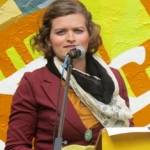
Amy Scheidegger
Artists As Arts Administrators: Encouraging Blurred Divisions of Labor
Posted by Apr 17, 2015 0 comments

Amy Scheidegger
I’m a freelance artist who earns a living illustrating stories and adjunct teaching for an undergraduate arts management program. I recently served on a panel called “Putting Artists First: Arts Incubators and Other Support Structures” as Founder of the Artistic Rebuttal Project, where two other arts administrators and I talked about facilitating artist support. A discussion about why the panel was called “Putting Artists First” as opposed to putting the process of art-making/facilitating first arose—both arts and the administering of them rely on the other to make an impact. While in my personal life, I consider an artist any person who creates something tangible or audible, I’m defining “artist” for this post as anyone who aspires to earn a living with the work they create. The consensus in the room was that artists should be trained in administration if they have any aspirations in earning a living as an artist. But we soon confronted a different inquiry…we don’t ask arts administrators to become artists, why do we ask artists to administer?
As an artist who earned a Masters in Arts Administration, I found necessity in knowing how art organizations function. This is because at one time I was a fresh-faced art school graduate with a painting degree who landed an admin job in my local arts council only to be let go 4 months later for still mysterious reasons. In retrospect, I’m glad it happened. It was the shock of being forced to resign from the place that had fostered my childhood arts ambitions that drove me to learn the field’s best practices.
I find being skilled and literate in both the creating of and administration of art not only a benefit but fundamental. During the panel, a devil’s advocate rebutted our assertions that artists hone both their talent and their business sense. Paraphrasing: “We don’t ask arts administrators to become artists…that’s why ‘divisions of labor’ exist. If time is the currency of creativity, artists spending time learning administration is time taken away from making art.” While I agree that time is the currency of creativity, my rebuttal comes in two parts:
- Labor divides in the art world are tricky. Does each discipline indicate a divide? Artists train themselves to be skillful in many disciplines and to regularly research others, even administration and non-art fields. If they don’t take the time to learn the art of administration, they’d either struggle beyond imagination or need to recruit someone for help. Help requires time and money, which an artist without representation sometimes can’t spare. If they can, there’s still the time it takes to articulate the multi-faceted details of the work, its context/intention, and how to present it to the public. Once an artist has to share those realities—they’re administering.
- OMG do you think artists spend 24 hours a day, 7 days a week making art? Are we art machines churning out masterpieces? What torture! We need breaks. We need socialization. We need time to not make anything. Why not use that time to learn how to present our work and ourselves to the world? Why not take a class about the use of technology in aiding the dissemination of what we create, how to dream up collaborations, etc.? Doesn’t that make us better artists; better commentators of the world we live in?
I think artists and arts administrators are having this existential conversation about who’s responsible for what because we’ve reached an era where artists no longer rely on third parties for success. They’ve recognized that it’s more difficult for living artistic voices to fit into traditional arts venues. Success means creating a strong, loyal audience base themselves; with the free digital technologies of today it’s easier than ever to grow one. Having a physical “place” to show their work is a nice thing to have, but it’s just not the norm anymore.
The impact of this shift in how people experience art is artists are now creating artwork AND creating communities of experimentation, flexibility and inclusion. In these spaces that exist either physically or digitally, the audience, more than any formalized institution, establishes how they want to interact with and comment on art forms.
The arts and culture field at large should participate in artists taking the reins in arts administration because the old methods of arts marketing and fundraising are tired. They’re tired because arts administrators are tired of having the same sets of tools to convince a largely digital audience to spend money to show up in person. The best way to encourage attendance in this century is having a digital entry point and active, meaningful participation—and I believe artists who understand arts administration can be the most successful at harnessing digital media to inject those meaningful exchanges.
Interested in joining the conversation? Meet us in Chicago for the Arts Leadership Precon during Annual Convention 2015!
